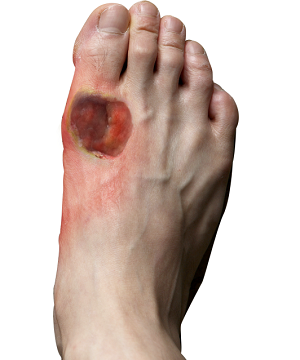-
Are you having high diabetes?
-
Does an injury to either of the feet taking longer than usual to recover?
-
Has your foot changed its colour over a period of time?
If yes, then it is time to seek help of diabetic foot specialist!
What is Diabetes Foot?

Potential Complication of Diabetes Foot
Damage of blood vessels may also mean that feet are not getting ample oxygen and blood and hence injury may take longer to heal. Infections that do not heal can cause skin and tissue to die, also known as gangrene. The dead tissue turns black and the entire foot gets discoloured. To stop further spread of infection treatment can involve surgery to remove a toe, foot, or part of a leg (amputation).
It is always important to recognize early warning signs of foot problems in order to address the ailment at the earliest. Here are some of the symptoms that diabetes foot comes with. You need to look out for:
-
Burning, tingling, or painful feet
-
Loss of sensation of heat, cold, or touch
-
Changes in colour or shape of your feet
-
Loss of hair on the toes, feet, and lower legs
-
Thickening and colour change (yellow) of the toenails
-
Onset of blisters, sores, ulcers, infected corns, or ingrown toenails
-
Cracking of the skin of the feet, especially the heels, due to dry skin
Contact your doctor if your symptoms get worse or you experience any of the following:
-
Your leg looks pale or blue
-
Your leg becomes cold
-
Chest pain accompanies leg pain
-
Your leg becomes red, swollen, or hot
-
New sores or ulcers develop and do not heal
-
You experience fever, chills, weakness, or other signs of infection
How to Avoid Losing Foot (Amputation) in Diabetes Foot?
To decrease the possibility of an amputation, you must understand the causes that lead to amputation. You can avoid amputation of diabetes foot by following three main ways of prevention; primary, secondary and tertiary.
Primary prevention (Prevention of Diabetes foot):
Includes stopping wounds before they happen.
- Stop smoking
- Follow a regular exercise program that includes walking
- Eat a balanced diet with proper nutrition
- Lose weight
- Treat conditions such as diabetes, high blood pressure, or high cholesterol
Our Specialist

Dr. Nitish Jhawar
M.S., FMAS, FIAGES, FALS, FACRSI
Fellow Advance Laparoscopic Surgery
Fellow Colorectal Surgery USA
Senior Laparoscopic & Colorectal Surgeon
Phone No: +91 9322 229 159
Email Id: info@neoalta.com


